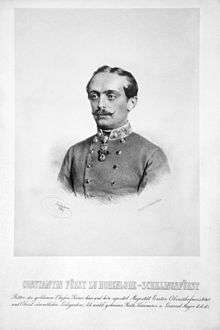Konstantin of Hohenlohe-Schillingsfürst
Konstantin Viktor Ernst Emil Karl Alexander Friedrich Prinz zu Hohenlohe-Schillingsfürst (born September 8, 1828, Schloss Schillingsfürst near Rothenburg ob der Tauber, Bavaria; died February 14, 1896, Vienna)[1] was a k.u.k. First Obersthofmeister (Lord High Steward or the chief of staff of the royal court) and General of the Cavalry of Austria-Hungary.

Biography
Family
Prince Konstantin of Hohenlohe-Schillingsfürst was the youngest son of Fürst Franz Joseph, 5th Prince of Hohenlohe-Schillingsfürst and his wife, Caroline Friederike Constanze of Hohenlohe-Langenburg. He had three older brothers who achieved high positions: Victor Herzog von Ratibor, President of the Prussian House of Lords, Chlodwig zu Hohenlohe-Schillingsfürst, Chancellor of Germany, and Gustav Adolf, Cardinal Prince of Hohenlohe-Schillingsfürst. In addition, he had three sisters and two other brothers died at a young age.
In 1859 Konstantin married Princess Marie zu Sayn-Wittgenstein (1837–1920) at Weimar. She was the daughter of Fürstin Carolyne zu Sayn-Wittgenstein (1819–1887) who after her divorce lived with Franz Liszt since 1848 at Weimar. In 1861 he bought Palais Dobner-Dobenau in Vienna, and the couple moved in the following year. His wife became a sponsor of Vienna's cultural life and a supporter of its social institutions. The couple had six children:
- Prince Franz Joseph zu Hohenlohe-Schillingsfürst (1861–1871)
- Prince Konrad of Hohenlohe-Schillingsfürst (1863–1918), Prime Minister of Austria-Hungary
- Prince Philipp zu Hohenlohe-Schillingsfürst (1864–1942), Pater Konstantin OSB
- Prince Gottfried zu Hohenlohe-Schillingsfürst (1867–1932), married Erzherzogin Maria Henriette von Österreich-Teschen (1883–1956)
- Prince Wolfgang zu Hohenlohe-Schillingsfürst (1869–1883)
- Princess Dorothea zu Hohenlohe-Schillingsfürst (1872–1954)
Career
Hohenlohe went to school at the Maria-Magdalenen-Gymnasium, Breslau graduating with the Abitur in 1848. The same year he joined the military of the Austrian Empire and served in a campaign in Northern Italy in 1849. In 1854 he entered service at the Royal Court in Vienna. He advanced becoming Aide-de-camp of Emperor Franz Joseph I. in 1859 and First "Obersthofmeister" with the elevated appointment to "Fürst" in 1866.[2] He was seen as the perfect courtier, always in agreement with the political views of the Emperor. As the highest court official, Hohenlohe had many administrative and representative duties and was at the center of the political and cultural life at the Austrian Court. After the Ausgleich of 1857, the term k.u.k. was added to his title signifying that his duties were to both parts of Austria-Hungary.[1]
In 1857, Emperor Franz Joseph I of Austria issued the decree "I have resolved to command" (Es ist Mein Wille at Wikisource) ordering the demolition of the city walls and moats. In his decree, he laid out the exact size of the Ringstrasse, the new representative boulevard, as well as the geographical positions and functions of the new buildings. Hohenlohe was responsible for buildings and properties of the Royal Court along the Ringstrasse as well as the completion of the Hofoperntheater, and the new construction of the Hofburgtheater und of two new museums, the Kunsthistorisches Museum and the Naturhistorisches Museum. The construction of the Neue Burg at the Hofburg was not completed until the First World War. Hohenlohe participated in the development of the Wiener Prater where the World Exhibition took place in 1873. The Konstantinhügel in the Prater is named after him. Hohenlohe also oversaw work for the Vienna Danube regulation.[3]
Hohenlohe worked until his death in 1896 and was succeeded by Rudolf von Liechtenstein.
Honors and dedications
- Honorary member of the Gesellschaft der Musikfreunde, 1870
- Honoray Kurator of the Academy of Fine Arts Vienna, 1873
- Honorary Kurator of the Museum of Applied Arts, Vienna, 1873
- Member of the Herrenhaus of Austria
- Recipient of the Order of Saint Stephen of Hungary, 1873[4]
- Recipient of the Order of the Golden Fleece, 1867[5]
- Recipient of the Order of the Black Eagle, and many more.
Johann Strauss Jr. dedicated his waltz Geschichten aus dem Wienerwald to Hohenlohe in 1868 and Anton Bruckner dedicated his Symphony No. 4 in E-flat major to him in 1873.
Literatur
- "Hohenlohe-Schillingsfürst Konstantin Prinz zu". In: Österreichisches Biographisches Lexikon 1815–1950 (ÖBL). Vol. 2, Austrian Academy of Sciences, Vienna 1959, p. 393 f. (Direct links to "p. 393", "p. 394")
- Martina Winkelhofer-Thyri: Prinz Constantin zu Hohenlohe-Schillingsfürst (1828–1896). Der große Unbekannte am Wiener Hof. In: Alma Hannig, Martina Winkelhofer-Thyri (Hrsg.): Die Familie Hohenlohe. Eine europäische Dynastie im 19. und 20. Jahrhundert. Verlag Böhlau, Köln 2013, ISBN 978-3-41222201-7, S. 181–198.
References
- Austria Forum: Entry for Konstatin zu HS
- See Hof- und Staatshandbuch des Kaiserthumes Österreich, Wien 1868, S. 9.
- Obituary, Wiener Salon, February 15, 1896
- "A Szent István Rend tagjai" Archived 22 December 2010 at the Wayback Machine
- Boettger, T. F. "Chevaliers de la Toisón d'Or - Knights of the Golden Fleece". La Confrérie Amicale. Retrieved 25 June 2019.